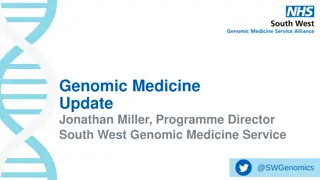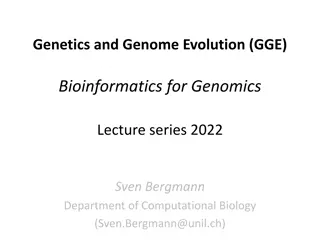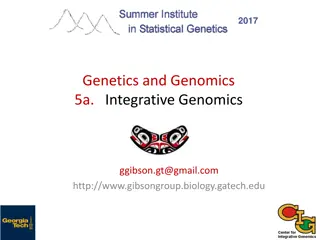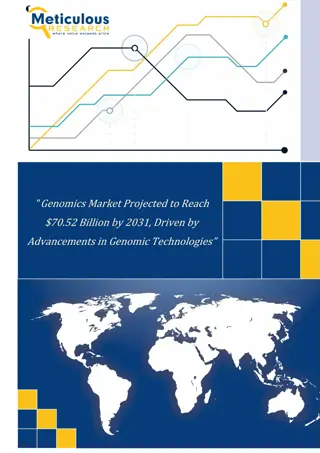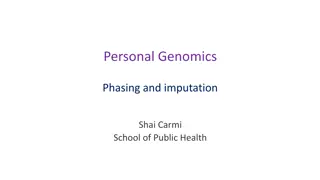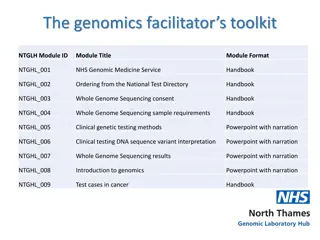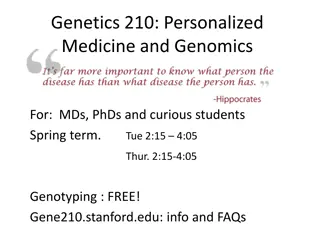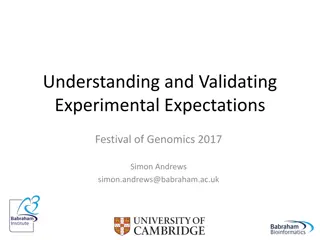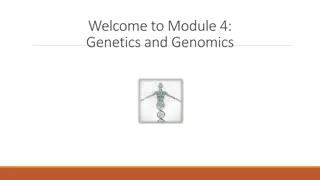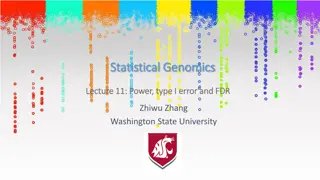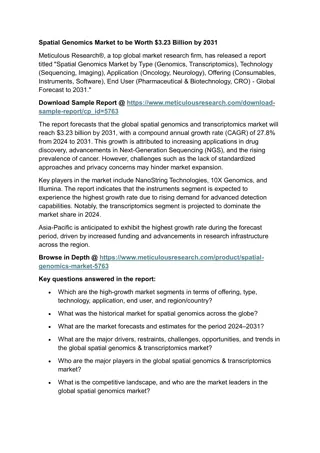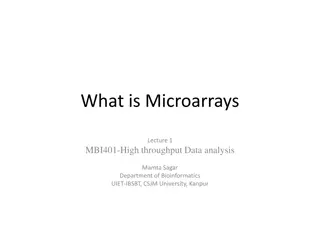Genomics: Study & Potential
Unveil the realm of genomics with in-depth insights into genetic sequences and their impact on health and development. Explore the vast potential of genomics research in addressing global health challenges and reducing inequalities.
Download Presentation

Please find below an Image/Link to download the presentation.
The content on the website is provided AS IS for your information and personal use only. It may not be sold, licensed, or shared on other websites without obtaining consent from the author.If you encounter any issues during the download, it is possible that the publisher has removed the file from their server.
You are allowed to download the files provided on this website for personal or commercial use, subject to the condition that they are used lawfully. All files are the property of their respective owners.
The content on the website is provided AS IS for your information and personal use only. It may not be sold, licensed, or shared on other websites without obtaining consent from the author.
E N D
Presentation Transcript
StudyMafia.Org Genomics Submitted To: Submitted By: Studymafia.org Studymafia.org
Table Contents Definition Introduction About Genomics Potential of Genomics Genomics & Global Inequality Conclusion 2
Definition Genomics is the study of all of a person's genes (the genome), including interactions of those genes with each other and with the person's environment. 3
Introduction An organism's complete set of DNA is called its genome. Virtually every single cell in the body contains a complete copy of the approximately 3 billion DNA base pairs, or letters, that make up the human genome. With its four-letter language, DNA contains the information needed to build the entire human body. 4
About Genomics Genomics is the study of the total or part of the genetic or epigenetic sequence information of organisms, and attempts to understand the structure and function of these sequences and of downstream biological products. Genomics in health examines the molecular mechanisms and the interplay of this molecular information and health interventions and environmental factors in disease. 6
About Genomics Human genomics is not the only part of genomics relevant to human health. The human genome interacts with those of a myriad other organisms, including plants, vectors and pathogens. Genomics is considered across all organisms, as relevant to public heath in human populations. In addition to genomics knowledge, we also considers technologies that make use of genomics knowledge. 7
About Genomics The main difference between genomics and genetics is that genetics scrutinizes the functioning and composition of the single gene where as genomics addresses all genes and their inter relationships in order to identify their combined influence on the growth and development of the organism. 8
Potential of Genomics The role of human genomics research and related biotechnologies has the potential to achieve a number of public health goals, such as to reduce global health inequalities by providing developing countries with efficient, cost-effective and robust means of preventing, diagnosing and treating major diseases that burden their populations. 9
Potential of Genomics It is a new and rapidly evolving branch of science and the full future role of genomics for the provision of health care is far from clear. However, it does offer the long-term possibility of providing new approaches to the prevention and management of many intractable diseases. Hence it is important to prepare society for the complexities of this new field, to ensure that its benefits are distributed fairly among the countries of the world, 10
Potential of Genomics It is a new and rapidly evolving branch of science and the full future role of genomics for the provision of health care is far from clear. However, it does offer the long-term possibility of providing new approaches to the prevention and management of many intractable diseases. Hence it is important to prepare society for the complexities of this new field, to ensure that its benefits are distributed fairly among the countries of the world, 11
Genomics & Global Inequality The global burden of disease and other health issues is disproportionately carried by low- and middle-income countries, while many of the emerging treatment options are available largely in wealthier nations. Genomics is affected by this global health imbalance and is currently experiencing a substantial divide that is impeding the progress of genetic sciences in low- to middle-income countries. 12
Genomics & Global Inequality Global inequalities in the availability, quality and use of genetic technologies, genomic research as well as provision of genomic services are widening due to a multitude of reasons. These include a lack of financial resources, lack of health services and infrastructure or simply the presence of more compelling health priorities as in the case of infectious diseases like TB and HIV/AIDS. 13
Genomics & Global Inequality Genome related technologies can contribute to improving global health equity. To do so, the genomic health divide must be kept in check and ultimately bridged through equitable economic investment, clinical research, and provision and use of genomic services and technologies globally. 14
Genomics & Global Inequality The exchange of existing information, expertise and technologies between the high income and low-income countries can speed up this process. The Human Genetics programme (HGN) provides WHO Member States with a clear understanding of the opportunities and challenges within genomics that are relevant to the achievement of their respective public health targets. 15
Conclusion Genomics is the study of the total or part of the genetic or epigenetic sequence information of organisms, and attempts to understand the structure and function of these sequences and of downstream biological products. 17
References Google.com Wikipedia.org Studymafia.org Slidespanda.com
Thanks To StudyMafia.org



